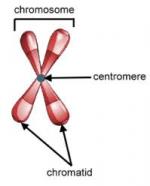|
This section contains 562 words (approx. 2 pages at 300 words per page) |

|
World of Anatomy and Physiology on Heinrich Wilhelm Gottfried von Waldeyer-Hartz
Heinrich Wilhelm Gottfried von Waldeyer-Hartz was a professor of anatomy and histology who coined the word "chromosome" in 1886. Waldeyer, noting the ability of thread-like structures in the nucleus to be stained by the dye fuchsin, named them "chromo" meaning color, and "soma", meaning body. Waldeyer also coined the term "neuron." In 1884, he described an area in the pharynx near the tonsils that has come to be known as Waldeyer's tonsillar ring. His contributions were critical to the science of neurology and to the understanding and treatment of cancer.
Waldeyer was born in Germany in Hehlen, a small village near Braunschweig. In 1856, at the age of twenty, he attended Göttingen University where he studied mathematics and then medicine, specializing in anatomy. Waldeyer then taught at the university in Königsberg, Germany, for two years and then at the University of Breslau, Germany, for eight years. In...
|
This section contains 562 words (approx. 2 pages at 300 words per page) |

|


